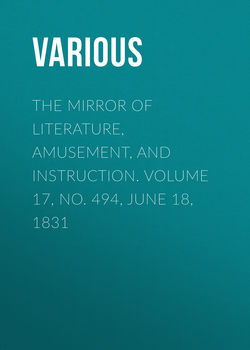The Mirror of Literature, Amusement, and Instruction. Volume 17, No. 494, June 18, 1831

Реклама. ООО «ЛитРес», ИНН: 7719571260.
Оглавление
Various. The Mirror of Literature, Amusement, and Instruction. Volume 17, No. 494, June 18, 1831
EXETER HALL, STRAND
WILLS OF SHAKSPEARE, MILTON AND BUONAPARTE
VERNAL STANZAS
POPULAR SUPERSTITIONS
LINES
PARLIAMENTARY SCRAPS
SONNET
THE COSMOPOLITE
HINTS FOR SELF-ADVANCEMENT; OR, HOW TO MAKE ONE'S WAY IN THE WORLD
THE NATURALIST
THE WHITE-HEADED, OR BALD EAGLE
NOTES OF A READER
THE LATE MRS. SIDDONS
SPIRIT OF THE PUBLIC JOURNALS
THE TWO MUNCHAUSENS
THE MISER'S GRAVE
THE SELECTOR; AND LITERARY NOTICES OF NEW WORKS
PARIS AND ITS HISTORICAL SCENES
REFORM OF EARLY PARLIAMENTS
THE TOPOGRAPHER
TRAVELLING NOTES IN SOUTH WALES
THE GATHERER
EPITAPHS
FOR ALL FAMILIES
Отрывок из книги
We rejoice to see the site of Burleigh House partly occupied by the above Building. Its object is to afford accommodation for the meetings of Philanthropic Societies—so that whatever may be the olden celebrity of the spot, it is reasonable to expect that its present appropriation will be associated with the most grateful recollections.
This building is, perhaps, the most perfect erection of its kind in England. The approach from the Strand is remarkably modest: it is by a very narrow, though very chaste, door-way, situated between two Corinthian columns and pilasters. Within the door is a hall, with two flights of steps, which afterwards unite, and lead up to the entrance of the great hall itself; the hall below leads into a broad passage, which extends to the farther extremity of the building, opening right and left into various offices. On entering the door of the great hall, a vast and splendid room is presented to view, with scarcely a single interruption to the eye throughout its whole extent, capable of containing, with comfort, more than 3,000 persons. The floor is covered with substantial oak seats, equal to the accommodation of 2,500 persons. The greater portion of these are situated on a gentle rise, to permit a perfect view of the platform on which the proceedings take place. The platform is raised about six feet from the floor, and extends the whole breadth of the room, curving inwards, the extremities bending towards the audience: it contains seats for nearly 300 individuals. Behind this gallery again, are very capacious recesses, which will hold from three to four hundred persons. The lower part of the walls of the room is quite plain, the architect, probably, regarding the audience as a sufficient ornament in that quarter, though the rising of the seats would obscure carved-work if it were there. The windows are at a considerable height from the ground, and are of dimmed glass, with a chaste and classical border. The ceiling, which is at a noble height, is beautifully laid out in squares, with borderings and rosettes. An oblong opening occurs in the centre, with massive beams stretching across, presenting to view an erection in the roof, a form of construction, probably, necessary to so immense a mass of roofing, and serving also for the purposes of ventilation, as it contains windows at each end. There are four pillars near the end of the hall, rising to the ceiling, the capitals of which, as also those of some pilasters at the upper extremity of the hall, are exquisitely carved in straw-coloured marble. Behind the platform are numerous and convenient committee-rooms. The word "Philadelpheion," which may be rendered "loving brothers," is carved in Greek capitals over the entrance in the Strand.1
.....
I shall here recount one of the most extraordinary tales relating to this subject that I ever heard; I believe the solution is evident, and I am not aware that it has appeared before; but if it has, some of the readers of the Mirror may not have seen it.
A surgeon of Edinburgh was confined to his bed by some illness, and at "the dewy hour of eve," when the room was lighted by nothing but the glimmering and flickering light of a wood fire, he perceived a female sitting at the foot of the bed clothed in white! Imagining that it was some defect in his sight, he gazed more intensely at it, still it was there. He then raised his hand before his eyes and he did not perceive it; on withdrawing it the apparition was there. Closing his eyes he went through a mathematical calculation to convince himself he was in his right senses; upon reopening them he still perceived her there. The fire then went out and he saw no more. I confess I see no difficulty in accounting for this, by supposing the gentleman was afflicted with that horrid disease of which Sir Walter Scott gives many cases in his Demonology and Witchcraft. Although I have no warrant for asserting spirits do not return, yet I must say, all the tales I have ever heard do not necessarily require any such interpretation on them. It may be true, and so may everything which we have no evidence against or for. If my opinion on the subject was to be shaken by anything, it would be with the following story, which was given to me by one whose veracity I have no reason to doubt.
.....